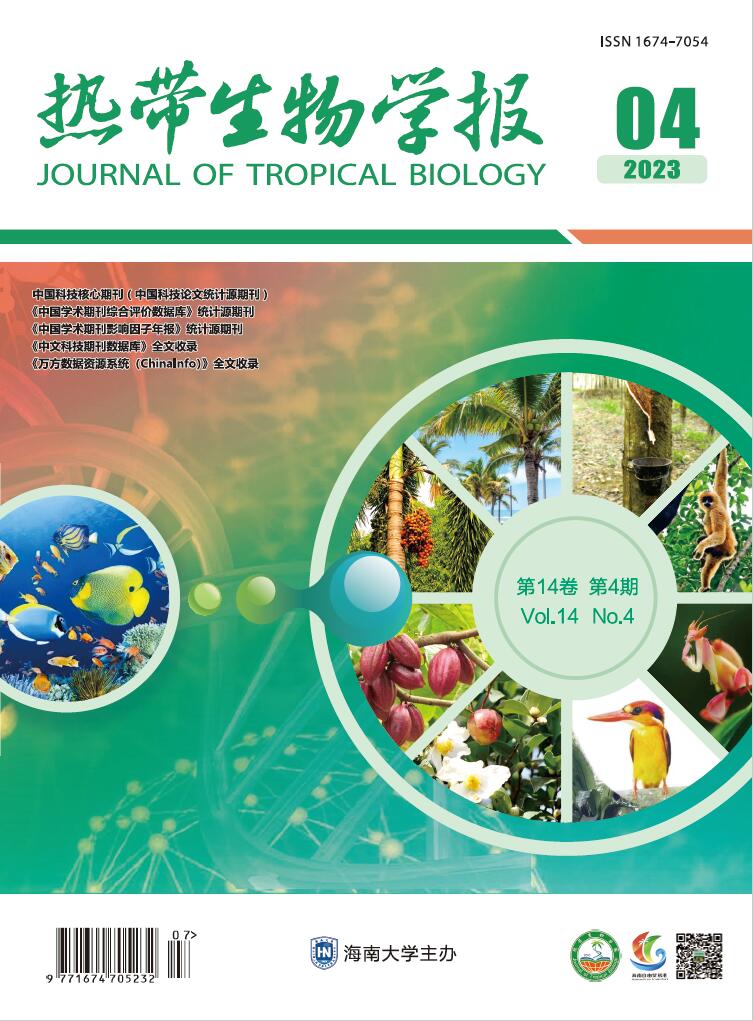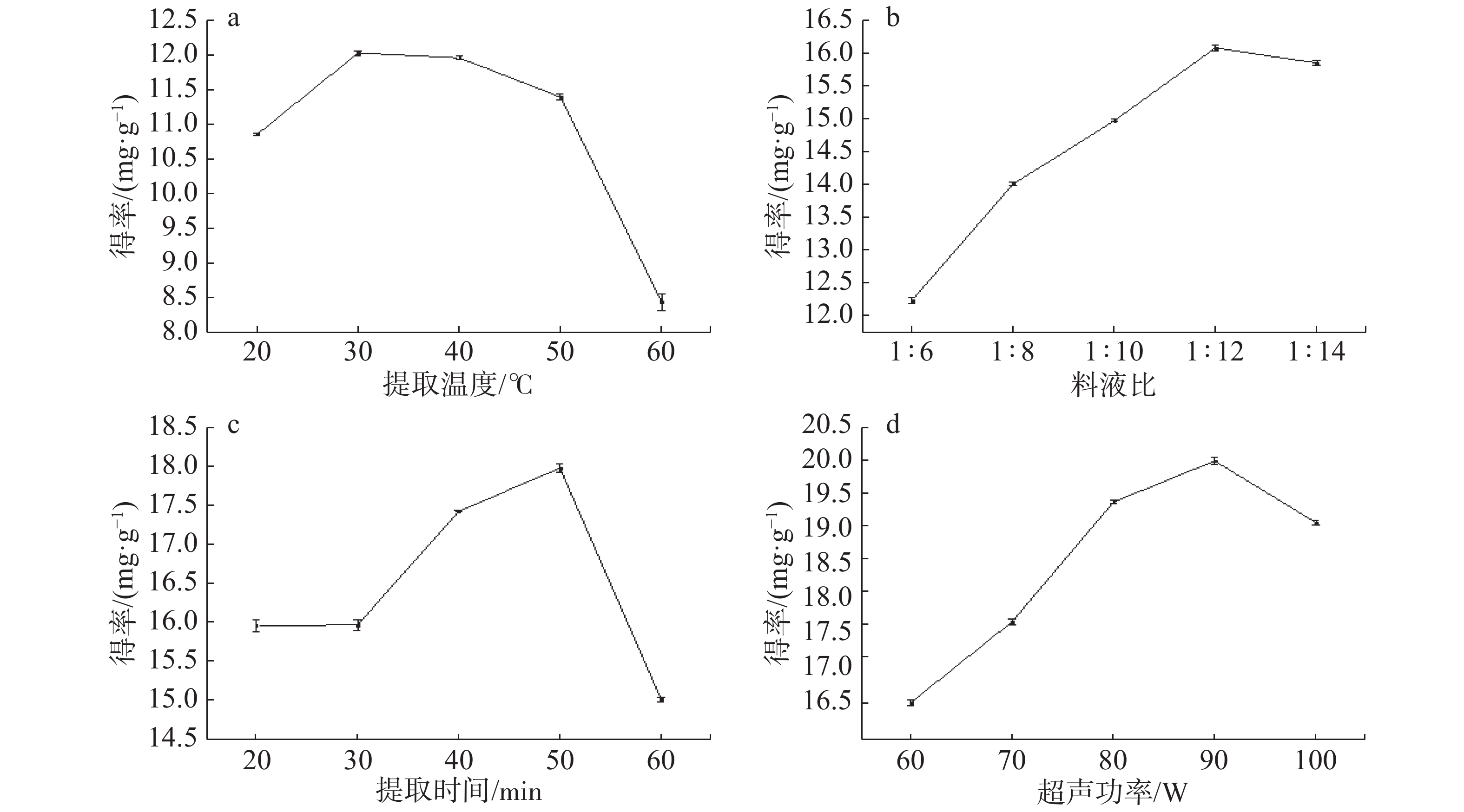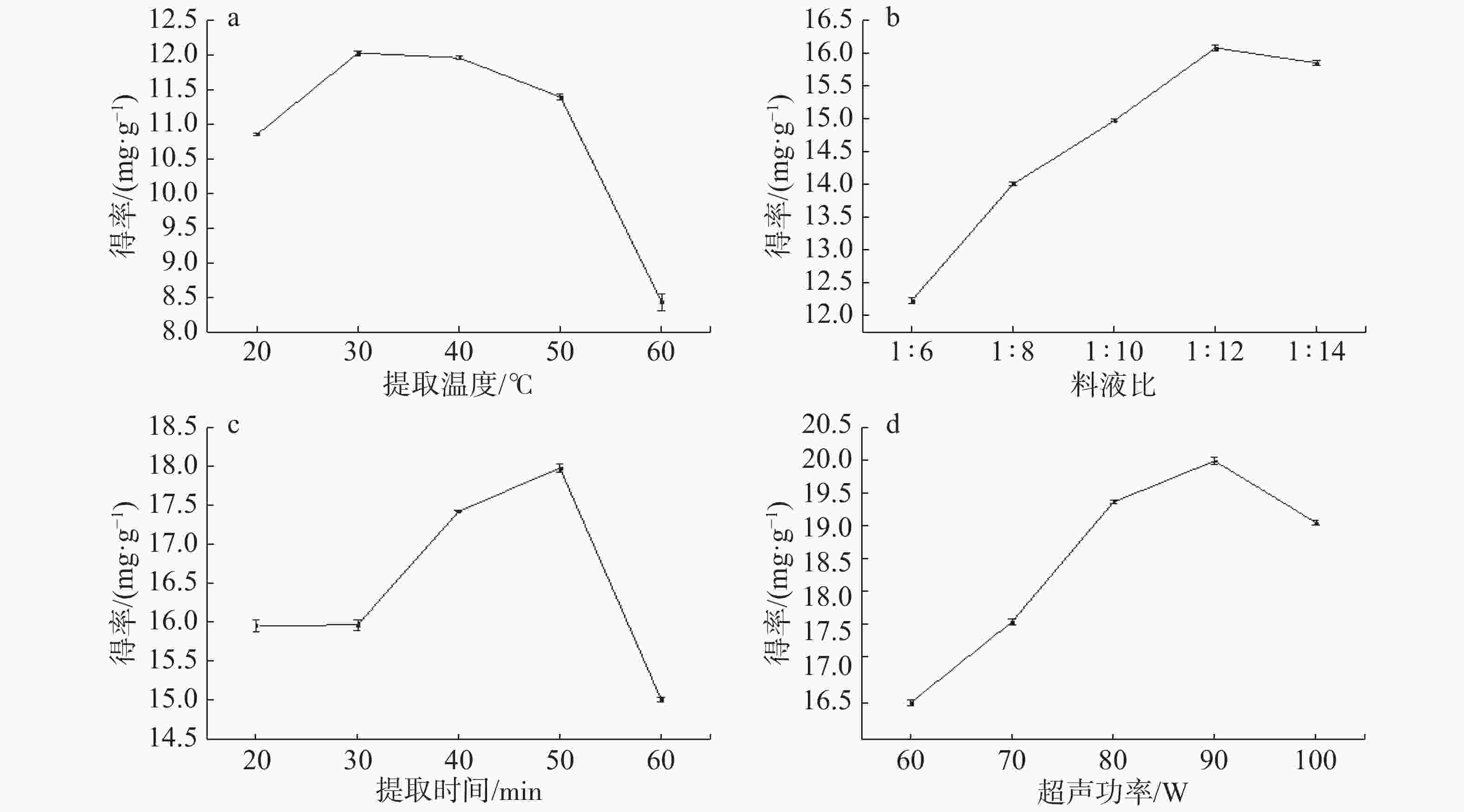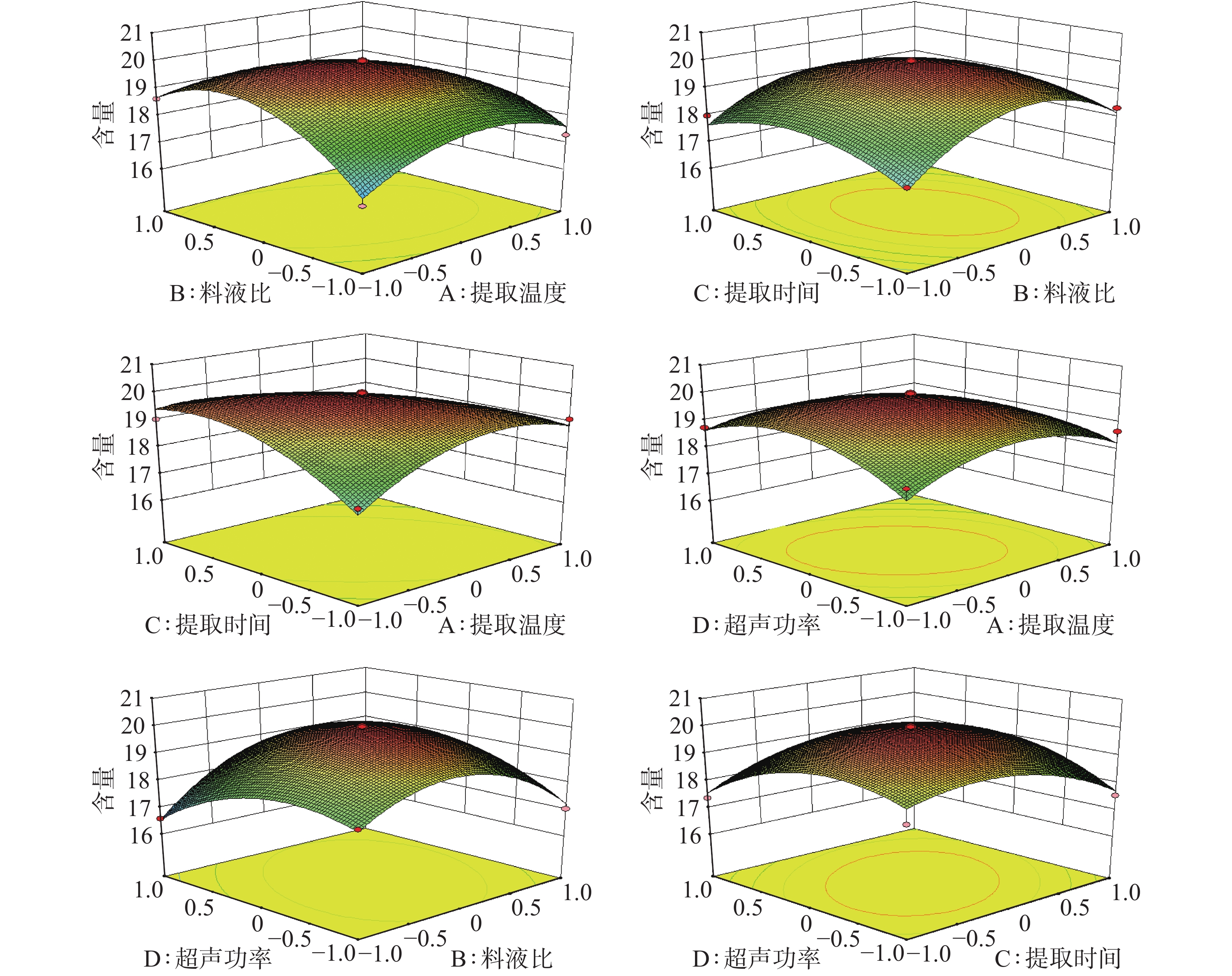-
桂枝为樟科植物肉桂(Cinnamomum cassia Presl)的干燥嫩茎,味辛辣、甘、药性较温和,具有发散、解表、行气等作用[1]。桂枝中化学成分包括挥发性成分、有机酸类、香豆素类等,其中,桂皮醛作为桂枝挥发油的主要有效成分,具有明显的镇痛解热、抗炎、抗甲型流感病毒、抗肿瘤等良好的药理作用[2-4],是桂枝茯苓胶囊、香桂化浊胶囊等药品的主成分之一。目前,提取桂皮醛的方法主要有浸渍法、水蒸气蒸馏法和超声波提取法等。超声波提取法较其他方法具有提取温度低、提取效率高、提取时间短的独特优势[5-10]。条件不同对桂皮醛的提取影响很大,故需对桂皮醛的提取工艺进行优化。目前,对于桂枝中桂皮醛的提取工艺研究,都采用普通正交试验[11-12]。虽然这种方法也考虑了多种因素的影响,但它不能在整个区域上找到因素和响应值之间的一个明确的函数表达式即回归方程,从而无法找到整个区域上因素的最佳组合和响应值的最优值。而响应曲面法(Response surface methodology, RSM)采用多元二次回归方法作为函数估计的工具,试验次数少、周期短、求得的回归方程精度高,是几种因素间交互作用的回归分析方法[13-15]。因此,本实验采用响应面法优化桂皮醛的超声提取工艺,提高桂皮醛的提取得率,以期为充分开发桂枝中桂皮醛提供可靠依据。
HTML
-
7890A气相色谱仪(美国安捷伦科技有限公司);FA2004型电子天平(上海精天电子仪器厂);KQ-500DE型数控超声波清洗器(昆山市超声仪器有限公司);桂枝药材(购于佳木斯市金天药店,经佳木斯大学药学院宗希明高级实验师鉴定);桂皮醛对照品购自美伦生物科技有限公司(纯度>99%,批号:14371-10-9)。
-
色谱柱:HP-5石英毛细管色谱柱(30 m×0.25 mm, 0.25 μm);进样口温度:250 ℃;检测器温度:260 ℃;载气:N2;进样量:0.2 μL;进样方式:分流进样;分流比为10∶1;柱流量:1 mL·min−1;程序升温:柱初始温度80 ℃, 以3 ℃·min−1的速率升至100 ℃,再以10 ℃·min−1的速率升到 150 ℃,再以 5 ℃·min−1的速率升到170 ℃,再以15 ℃·min−1的速率升到 245 ℃。
-
将桂枝药材粉碎,过60目筛,取桂枝粉末2 g置于50 mL具塞锥形瓶中加入24 mL甲醇,称重,在水浴50 ℃下加热2 h后在50 ℃和90 W的超声波中超声50 min,用甲醇补足重量,过滤后过0.45 μm的微孔滤膜,得供试品溶液,低温储存,备用。
-
取桂皮醛对照品适量,精密称定,用甲醇定容至50 mL。即得0.53 g·L−1的桂皮醛对照品溶液。
-
精密吸取对照品1,2,3,4,5 mL置于10 mL的量瓶中定容,配制成浓度分别为0.05,0.11,0.16,0.21和0.26 g·L−1的桂皮醛对照品溶液。精密吸取0.2 μL注入GC仪中,按“1.2”项的色谱条件测定峰面积。以桂皮醛浓度为横坐标,峰面积为纵坐标,绘制标准曲线,得出回归方程y=14.7x−11.355,r=0.991 5,结果表明,桂皮醛在(0.05~0.26) g·L−1之间线性良好。
-
提取方法同“1.3”项,提取温度分别为20,30,40,50,60 ℃;料液比分别为(1∶6),(1∶8),(1∶10),(1∶12)和(1∶14) g·mL−1);提取时间分别为20,30,40,50,60 min;超声功率分别为60,70,80,90,100 W。固定因素为:提取温度50 ℃、料液比1∶12、提取时间50 min、超声功率90 W。
-
根据Box-Behnken试验设计原理,在单因素试验基础上,采用4因素3水平响应曲面法,分析并优化桂枝中桂皮醛的超声提取工艺。以提取温度、提取时间、超声功率、料液比为自变量(表1),设计29组试验,每次均精密称取2 g桂枝粉末,对提取物进行桂皮醛的得率测定。
因素 Factor 水平 Level A:提取温度/°C Extraction temperature 40 50 60 B:料液比/(g·mL−1)
Material/solution ratio1∶10 1∶12 1∶14 C:提取时间/min
Time duration for extraction40 50 60 D:超声功率/W Ultrasonic wave power 80 90 100 Table 1. Experimental factors and levels of extraction of cinnamaldehyde from cassia cinnamon
1.1. 材料
1.2. 气相色谱条件
1.3. 供试品溶液的制备
1.4. 对照品溶液的制备
1.5. 线性关系考察
1.6. 桂皮醛提取的单因素试验
1.7. 桂皮醛提取工艺的响应面试验
-
由图1-a可知,当超声提取温度在50 ℃以下时,随着温度的不断升高,桂皮醛得率逐步增加;温度为(20~50) ℃时,温度对桂皮醛得率的影响不是非常显著;温度超过50 ℃时,随着温度的升高,桂皮醛的得率降低,这可能是由于温度过高导致了桂枝中挥发油的挥发。因此,50 ℃为桂皮醛提取最佳温度。
由图1-b可知,当料液比为(1∶10)~(1∶12)时,得率上升最快;当料液比达到1∶12以后,伴随着料液比的继续增加,桂皮醛的得率变化不明显并且有所减少。为节约药材,因此选择1∶12的料液比进行提取。
由图1-c可知,随着超声提取时间的不断延长,(30~40) min中得率上升最快;当时间为50 min,桂皮醛的得率为最大;时间达到50 min后得率显著降低,可能是由于超声时间过长,分子进行热运动导致了挥发油的挥发。因此,超声提取时间选择为50 min。
由图1-d可知,功率在(70~80) W之间时,得率变化较为明显;当超声功率达到90 W时,桂皮醛提取量达到最多;超声提取功率超过90 W后得率下降,可能是由于超声功率过大,分子进行热运动导致了挥发油的挥发;因此超声提取功率选择为90 W。
-
根据响应曲面法优化试验设计,超声提取桂皮中的桂皮醛得率结果见表2。分析回归方程中显著性由F值来检验,Pr>F的值越小,则相应的变量显著性越高。通过对各影响因素试验优化,得到相应的二次回归方程模型:Y=19.91−0.33 A+0.21 B−0.055 C−0.13 D−0.66 AB−1.01 AC−0.46 AD−0.26 BC+0.62 BD+0.50 CD−0.98 A2−1.46 B2−0.83 C2−0.96 D2。对其进行多元回归方差分析,结果见表3。根据表3可看出,模型P<0.000 1,表现为高度显著,失拟误差为0.086 8,表现为不显著,说明本实验建立出来的模型可靠,回归值F=17.48,R2=0.945 9,表明拟合较好、可信度高。试验误差较小,用Design Expert 软件分析可知,可用此模型分析与预测桂皮醛最佳提取工艺。
编号
Code提取温度/°C
Extraction temperature料液比
Solid/liquid ratio提取时间/min
Time duration for extraction超声功率
Ultrasonic wave power得率/(mg·g−1)
Yield1 50 1∶12 50 90 19.57 2 60 1∶12 40 90 19.08 3 40 1∶10 50 90 16.69 4 50 1∶14 40 90 18.32 5 50 1∶10 60 90 17.98 6 60 1∶12 50 80 18.66 7 40 1∶12 40 90 17.68 8 50 1∶14 50 100 17.99 9 50 1∶14 60 90 17.93 10 40 1∶12 60 90 19.02 11 50 1∶12 50 90 20.00 12 50 1∶12 40 80 18.29 13 60 1∶10 50 90 17.29 14 50 1∶10 50 100 16.58 15 50 1∶12 50 90 20.04 16 40 1∶14 50 90 18.62 17 60 1∶14 50 90 16.58 18 50 1∶12 60 80 17.52 19 50 1∶12 60 100 18.58 20 40 1∶12 50 100 18.75 21 40 1∶12 50 80 18.36 22 60 1∶12 60 90 16.36 23 50 1∶12 50 90 20.01 24 50 1∶14 50 80 17.02 25 50 1∶12 50 90 19.99 26 60 1∶12 50 100 17.20 27 50 1∶10 50 80 18.11 28 50 1∶12 40 100 17.36 29 50 1∶10 40 90 17.32 Table 2. Extraction of cinnamaldehyde from cassia cinnamon by using ultrasonic wave in an experimental design based on the response surface methodology
方差来源
Variance source平方和
Sum of square自由度
Freedom均方
Mean squareF P 显著性
Significance模型 31.98 14 2.28 17.48 < 0.000 1 ** A 1.3 1 1.3 9.95 0.007 * B 0.52 1 0.52 3.95 0.066 7 C 0.036 1 0.036 0.28 0.606 4 D 0.19 1 0.19 1.43 0.250 9 AB 1.74 1 1.74 13.33 0.002 6 * AC 4.12 1 4.12 31.54 < 0.000 1 ** AD 0.86 1 0.86 6.55 0.022 7 * BC 0.28 1 0.28 2.11 0.168 5 BD 1.56 1 1.56 11.96 0.003 8 * CD 0.99 1 0.99 7.58 0.015 6 * A2 6.21 1 6.21 47.53 < 0.000 1 ** B2 13.85 1 13.85 105.96 < 0.000 1 ** C2 4.52 1 4.52 34.59 < 0.000 1 ** D2 6.01 1 6.01 45.96 < 0.000 1 ** 残差 1.83 14 0.13 -- -- 失拟误差 1.67 10 0.17 4.28 0.086 8 纯误差 0.16 4 0.039 -- -- 总误差 33.81 28 -- -- -- 注: **表示极显著差异(P<0.000 1),* 表示显著差异(P<0.05)。
Note: ** means highly significant difference at P<0.001; * means significant difference at P<0.05.Table 3. Significance test of regression model and variance analysis
-
根据二次回归方程绘制响应曲面的三维曲线,得到2个因素交互作用对响应值(桂皮醛得率)的影响,结果见图2。比较图2与表3可以看出,AC,A2,B2,C2,D2影响极其显著,A,AB,AD,BD,CD影响较为显著,B,C,D,BC交互项不显著。在以上影响因素中,由F值可以判断出各个因素对桂皮醛提取工艺的影响顺序为A>B>D>C。结果发现自变量对桂皮醛提取工艺的影响趋势先升高后下降,其中因素A,B影响最为显著,表现为响应面坡度陡峭,响应值的变化明显。
-
采用Design Expert软件对方程中的响应值(y)进行求解,得到桂皮醛得率的理论最佳工艺条件为:A=58.69 ℃ (提取温度),B=1∶11.6 (料液比),C=52.35 min(提取时间),D=91.49 W(超声功率)。根据实际操作的可行性,将上述优化条件修正为: 超声功率100 W,提取时间50 min,提取温度60 ℃,料液比1∶12,得出桂皮醛的理论得率为20.27 mg·g−1,在此条件下进行3次平行试验,提取的桂皮醛平均得率20.04 mg·g−1。,与预测值的相对误差为0.09%,偏差较小,说明响应曲面法优化超声提取桂枝中桂皮醛工艺的参数准确可靠,具有实际应用价值。
2.1. 桂皮醛提取的单因素试验结果
2.2. 桂皮醛提取工艺的响应面试验结果
2.3. 响应面分析与优化
2.4. 验证试验
-
本实验利用气相色谱法测定桂皮醛得率,其优点为专属性高、选择性好、灵敏度高、重现性好。在单因素试验基础上,采用响应曲面法从提取温度、料液比、提取时间和超声功率4个方面对超声波提取桂枝中桂皮醛进行了提取工艺优化。回归模型显著性检验及方差分析显示,模型P<0.000 1,表现为高度显著,失拟误差为0.086 8,表现为不显著,说明本实验建立出来的模型可靠,回归值F=17.48,r=0.945 9,表明拟合较好、可信度高。得到桂枝中桂皮醛的最佳提取工艺条件为:超声功率100 W,提取时间50 min,提取温度60 ℃,料液比1∶12,在此条件下桂皮醛的得率为20.04 mg·g−1,与预测值(20.27 mg·g−1)偏差较小,可以为实践所用。该工艺为桂皮醛的生产和应用提供了依据。









 DownLoad:
DownLoad:
